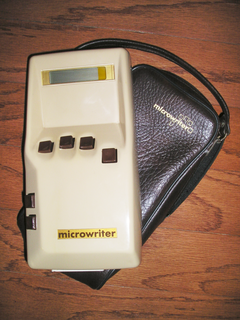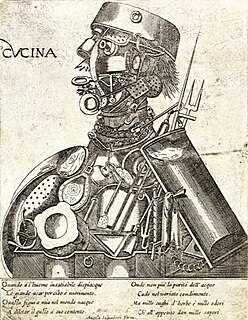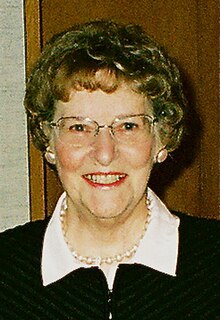
A keyset or chorded keyboard is a computer input device that allows the user to enter characters or commands formed by pressing several keys together, like playing a "chord" on a piano. The large number of combinations available from a small number of keys allows text or commands to be entered with one hand, leaving the other hand free. A secondary advantage is that it can be built into a device that is too small to contain a normal-sized keyboard.

A computer mouse is a hand-held pointing device that detects two-dimensional motion relative to a surface. This motion is typically translated into the motion of a pointer on a display, which allows a smooth control of the graphical user interface. The first public demonstration of a mouse controlling a computer system was in 1968. Originally wired to a computer, many modern mice are cordless, relying on short-range radio communication with the connected system.

Douglas Carl Engelbart was an American engineer and inventor, and an early computer and Internet pioneer. He is best known for his work on founding the field of human–computer interaction, particularly while at his Augmentation Research Center Lab in SRI International, which resulted in creation of the computer mouse, and the development of hypertext, networked computers, and precursors to graphical user interfaces. These were demonstrated at The Mother of All Demos in 1968. Engelbart's law, the observation that the intrinsic rate of human performance is exponential, is named after him.

Johns Frederick (Jeff) Rulifson is an American computer scientist.

SRI International (SRI) is an American nonprofit scientific research institute and organization headquartered in Menlo Park, California. The trustees of Stanford University established SRI in 1946 as a center of innovation to support economic development in the region.

A mousepad is a surface for placing and moving a computer mouse. A mousepad enhances the usability of the mouse compared to using a mouse directly on a table by providing a surface to allow it to measure movement accurately and without jitter. Some mousepads increase ergonomics by providing a padded wrist rest.
The "Yuri Rubinsky Memorial Award" was a prize that was awarded annually at the International World Wide Web Conference. Yuri Rubinsky, in cooperation with the International WWW Conference Committee (iW3C2), presented the SoftQuad Award for Excellence to Doug Engelbart at the Fourth International WWW Conference in Boston in December, 1995. Following his death in January 1996, the Yuri Rubinsky Insight Foundation took up the award. According to the foundation, it is given "to an individual who has contributed, through a lifetime of effort, to the care and feeding of the global information infrastructure." The award is accompanied by a cash payout of $10,000.

"The Mother of All Demos" is a name retroactively applied to a landmark computer demonstration, given at the Association for Computing Machinery / Institute of Electrical and Electronics Engineers (ACM/IEEE)—Computer Society's Fall Joint Computer Conference in San Francisco, which was presented by Douglas Engelbart on December 9, 1968.
The dynamic knowledge repository (DKR) is a concept developed by Douglas C. Engelbart as a primary strategic focus for allowing humans to address complex problems. He has proposed that a DKR will enable us to develop a collective IQ greater than any individual's IQ. References and discussion of Engelbart's DKR concept are available at the Doug Engelbart Institute.
SRI International's Augmentation Research Center (ARC) was founded in the 1960s by electrical engineer Douglas Engelbart to develop and experiment with new tools and techniques for collaboration and information processing.

William "Bill" K. English is an American computer engineer who contributed to the development of the computer mouse while working for Douglas Engelbart at SRI International's Augmentation Research Center. He would later work for Xerox PARC and Sun Microsystems.

In computer science, interactive computing refers to software which accepts input from the user as it runs.
NLS, or the "oN-Line System", was a revolutionary computer collaboration system developed in the 1960s. Designed by Douglas Engelbart and implemented by researchers at the Augmentation Research Center (ARC) at the Stanford Research Institute (SRI), the NLS system was the first to employ the practical use of hypertext links, the mouse, raster-scan video monitors, information organized by relevance, screen windowing, presentation programs, and other modern computing concepts. It was funded by ARPA, NASA, and the U.S. Air Force.

Eileen Clegg is an American visual journalist and founder of Visual Insight. Eileen combines experience with journalism and art as part of an evolving visual language. Eileen's murals are created in real time at a large scale and feature a combination of strategic quotes and ancient symbols to convey the "gestalt" of an event or meeting.

Intelligence amplification (IA) refers to the effective use of information technology in augmenting human intelligence. The idea was first proposed in the 1950s and 1960s by cybernetics and early computer pioneers.
Augmented cognition is an interdisciplinary area of psychology and engineering, attracting researchers from the more traditional fields of human-computer interaction, psychology, ergonomics and neuroscience. Augmented cognition research generally focuses on tasks and environments where human-computer interaction and interfaces already exist. Developers, leveraging the tools and findings of neuroscience, aim to develop applications which capture the human user's cognitive state in order to drive real-time computer systems. In doing so, these systems are able to provide operational data specifically targeted for the user in a given context. Three major areas of research in the field are: Cognitive State Assessment (CSA), Mitigation Strategies (MS), and Robust Controllers (RC). A subfield of the science, Augmented Social Cognition, endeavours to enhance the "ability of a group of people to remember, think, and reason."

Douglas "Doug" James Hilton is an Australian molecular biologist. He is the Director of the Walter and Eliza Hall Institute of Medical Research in Melbourne, Australia and Head of the Department of Medical Biology at the University of Melbourne. His research has focused on cytokines, signal transduction pathways and the regulation of blood cell formation (hematopoiesis). Since 2014, Hilton has been the President of the Association of the Australian Medical Research Institutes (AAMRI).

Elizabeth Jocelyn "Jake" Feinler is an American information scientist. From 1972 until 1989 she was director of the Network Information Systems Center at the Stanford Research Institute. Her group operated the Network Information Center (NIC) for the ARPANET as it evolved into the Defense Data Network (DDN) and the Internet.
The Oral History Metadata Synchronizer (OHMS) is a web application designed to enhance online access to oral history interviews. OHMS was originally designed and created by the Louie B. Nunn Center for Oral History, University of Kentucky Libraries in 2008 for deployment through the Kentucky Digital Library. In 2011, the Louie B. Nunn Center for Oral History received a grant from the Institute for Museum and Library Services to make the system open source and free to use with interoperability and sustainability as the primary goals. According to the Nunn Center, "The primary purpose for OHMS is to empower users to more effectively and efficiently discover information in an oral history interview online by connecting the user from a search result to the corresponding moment in an interview."
Engelbart's law is the observation that the intrinsic rate of human performance is exponential. The law is named after Douglas Engelbart, whose work in augmenting human performance was explicitly based on the realization that although we make use of technology, the ability to improve on improvements resides entirely within the human sphere.












